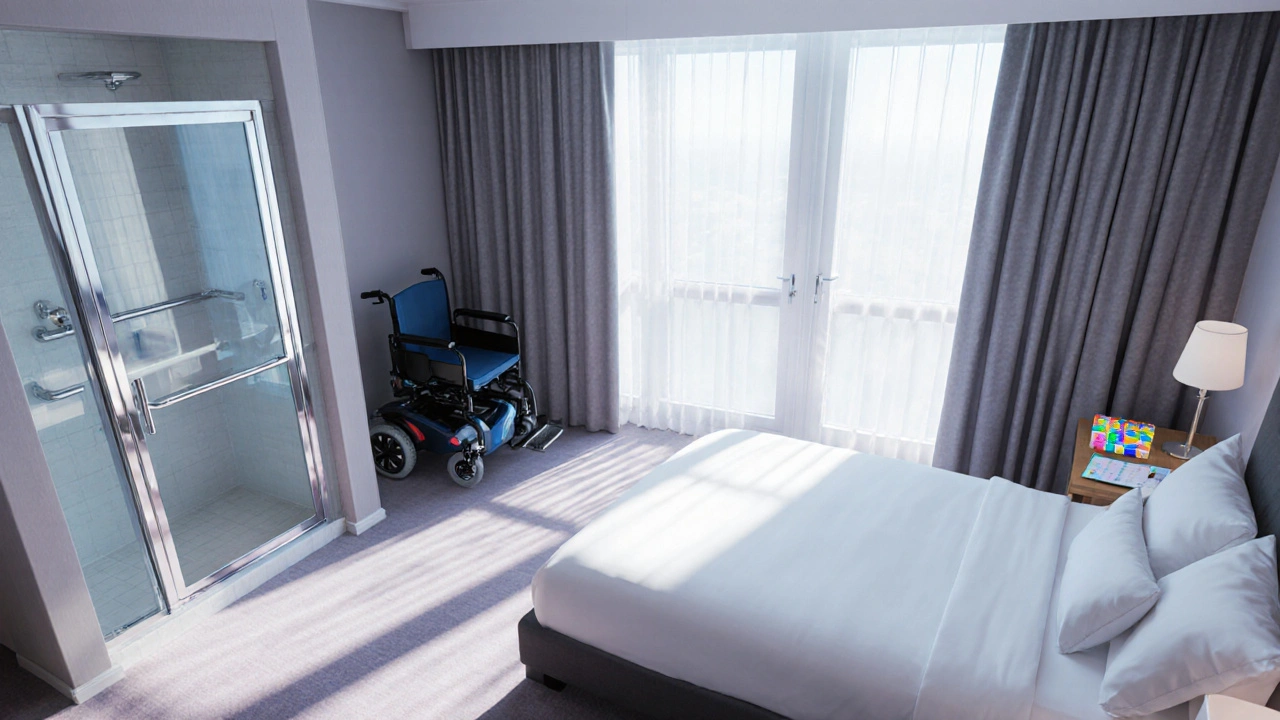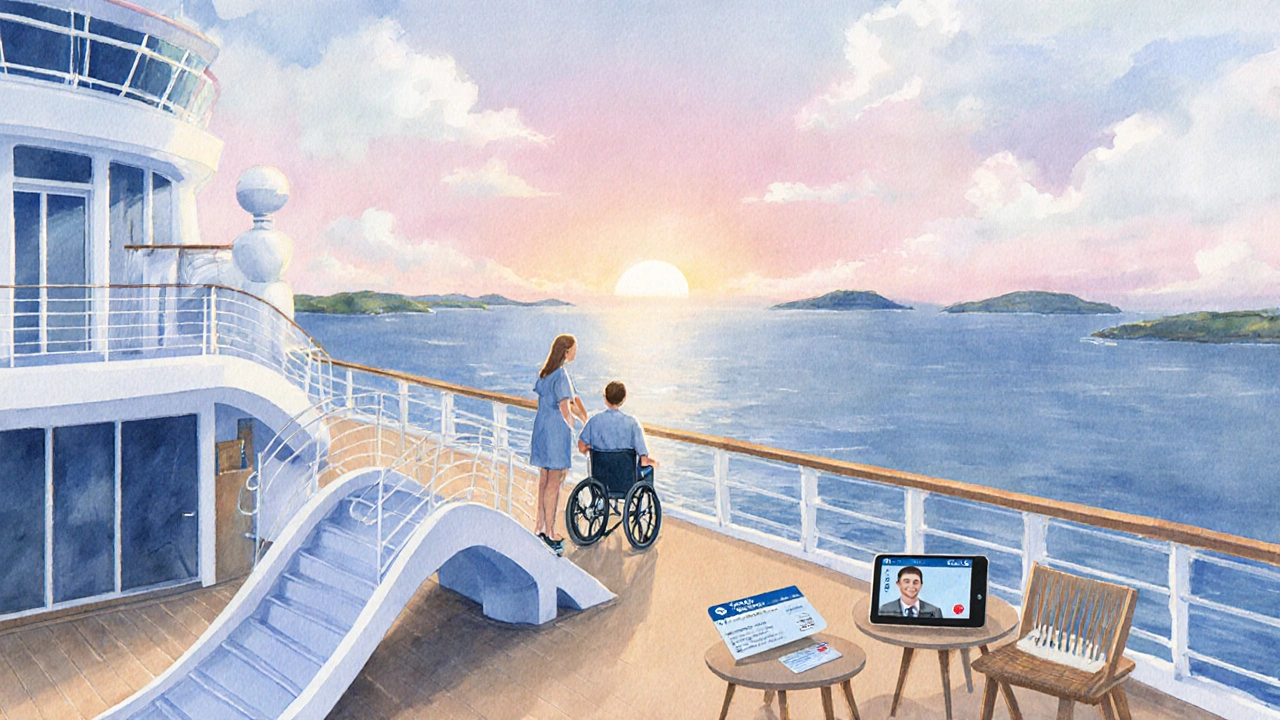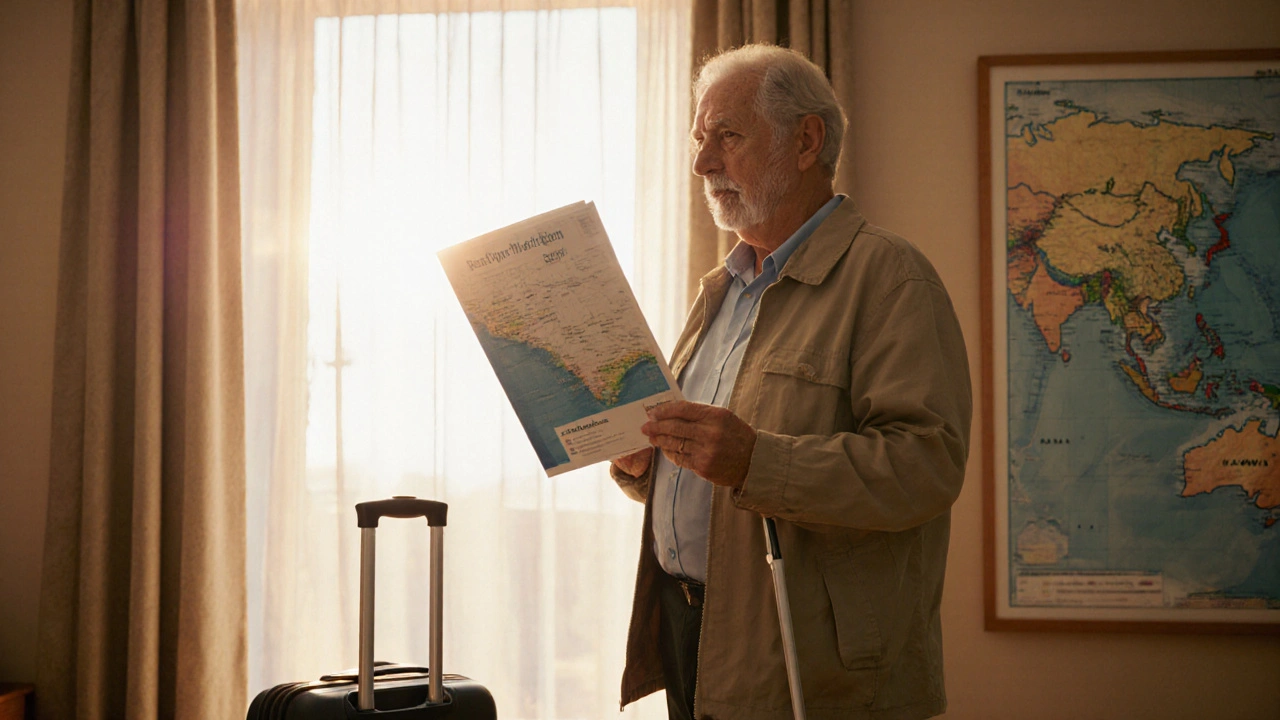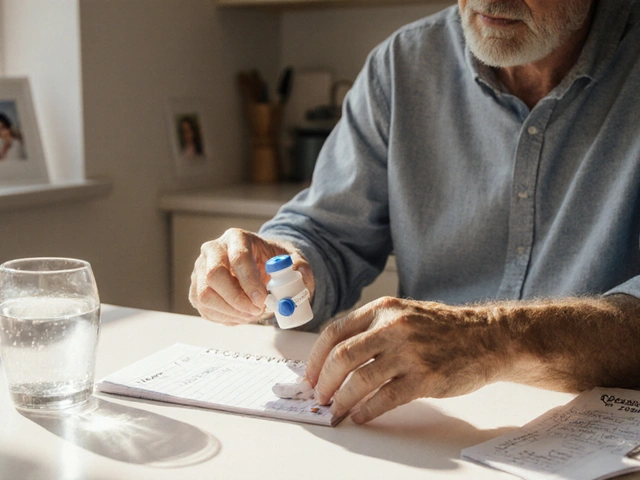Parkinson's Travel Planner
Enter your trip details and click "Plan My Trip" to see personalized recommendations.
- Medication Management: Pack a two-week supply in carry-on, split into daily pill organizers.
- Airport Security: Arrive early and inform TSA officers about your medical condition.
- Accommodation: Choose hotels with accessible rooms, grab bars, and roll-in showers.
- Emergency Preparedness: Keep a printed checklist of emergency contacts and medical information.
- Symptom Management: Take breaks every hour, stay hydrated, and use cueing devices for medication reminders.
Planning a vacation when you have Parkinson's disease is a progressive neurological condition that impacts movement, balance, and everyday tasks. It doesn’t mean you have to skip the adventure, but you do need a solid game plan. Below you’ll find practical steps, real‑world examples, and safety hacks that let you enjoy new places without constantly worrying about symptoms.
Key Takeaways
- Start with a symptom‑friendly itinerary and build in extra rest time.
- Pack medication in a travel‑ready kit and know the rules for airport security.
- Choose destinations and accommodations that offer wheelchair access, grab bars, and easy‑to‑reach bathroom facilities.
- Invest in travel insurance that covers medication loss and medical emergencies related to Parkinson's.
- Bring a trusted caregiver or travel companion and brief them on your specific needs.
1. Destination Planning with Parkinson's in Mind
The first step is choosing a place that matches your current ability level. Some factors to weigh include:
- Climate: Extreme heat can worsen tremors and fatigue. Coastal towns with mild weather are often easier on the body.
- Terrain: Flat, paved streets reduce the risk of falls. Avoid steep hills or cobblestone alleys unless you have a sturdy mobility aid you trust.
- Healthcare proximity: Check that a reputable hospital or clinic is within a short drive. A quick online search for "Parkinson's neurologist near [city]" can save panic later.
For example, a traveler from Durban who enjoys mild weather found the Cape Winelands perfect: vineyards offer level pathways, many hotels have wheelchair‑friendly rooms, and medical services are just a 30‑minute drive away.
2. Booking Accessible Accommodation
When you book a hotel, look for the phrase “accessible room” or “ADA‑compliant” in the description. Verify these details by calling the property and asking specific questions:
- Does the bathroom have grab bars and a roll‑in shower?
- Is there a wheelchair‑friendly entrance and elevator?
- Can the bed height be adjusted or is a low‑profile bed available?
Many chains now list these features in an “Accessibility” tab. If you’re unsure, ask for a caregiver to accompany you for the first night to assess comfort and safety.

3. Preparing Your Medication Kit
Medication management is the backbone of any Parkinson’s trip. Follow these steps:
- Pack a two‑week supply in your carry‑on, split into daily pill organizers.
- Carry a copy of your prescription and a doctor’s note (especially for liquid meds that exceed the 100ml limit for liquids).
- Label each container with the generic name, dosage, and timing - this helps airline staff if they need to inspect.
One traveler shared that keeping a small travel insurance policy that reimburses lost medication costs prevented a costly emergency when a bag was delayed in Dubai.
4. Navigating Airports and Security Checks
Airports can be stressful, but a few tricks make the process smoother:
- Arrive at least 2hours early for domestic flights and 3hours for international routes.
- Inform the TSA officer that you have a medical condition and request a private screening if needed.
- Keep a small, clear bag with your medication ready for inspection.
- Ask airline staff for a wheelchair or a moving‑aisle seat that offers extra legroom.
In the United States, the Air Carrier Access Act guarantees assistance, and similar regulations exist in the EU and South Africa. Knowing your rights can reduce anxiety.
5. Choosing the Right Mode of Travel
Different transport modes affect symptom control in distinct ways. Below is a quick comparison of the three most common options for Parkinson’s travelers.
| Aspect | Air Travel | Road Trip | Cruise |
|---|---|---|---|
| Duration of Sitting | Long stretches - may increase stiffness. | Flexible - can stop every 1-2hours. | Various - can move between decks. |
| Medication Access | Carry‑on needed; limited storage. | Easy storage in vehicle glove box. | Cabin staff can store meds safely. |
| Mobility Aid Compatibility | Wheelchairs allowed but require assistance. | Personal vehicle can be equipped with ramps. | Most ships have elevators and wheelchair decks. |
| Medical Support | In‑flight nurse optional; airport clinics available. | Depends on proximity to hospitals. | Onboard medical team, plus shore‑side facilities. |
| Stress Level | High due to security checks. | Moderate - can travel at your own pace. | Low - structured schedule, assistance everywhere. |
For many, a cruise offers the lowest stress environment because your cabin is a base, staff handle daily logistics, and you have regular access to medical rooms. However, if you prefer flexibility, a road trip lets you break up travel time and adjust medication timing more easily.
6. Managing Symptoms on the Go
Even with perfect planning, symptoms can flare. Keep these strategies handy:
- Stay hydrated: Dehydration can worsen blood pressure drops, leading to dizziness.
- Take breaks: Stand, stretch, or sit down every hour to reduce rigidity.
- Use cueing devices: Simple apps on your phone can remind you to take meds or do a quick walk.
- Practice deep breathing: Reduces anxiety that can amplify tremor intensity.
One traveler in Thailand used a portable vibration pad to ease muscle stiffness during long bus rides and found it cut downtime by half.

7. When an Emergency Happens
Despite best intentions, emergencies occur. Here’s a quick response checklist:
- Locate the nearest hospital that has a neurologist or movement‑disorder specialist.
- Call your primary doctor back home - many clinics have 24‑hour telehealth lines.
- Use your travel insurance policy number to cover ambulance or urgent care costs.
- Inform your caregiver or travel companion immediately so they can help with paperwork and medication adjustments.
Keep a printed copy of this checklist in your carry‑on; a digital copy can be lost if your phone battery dies.
8. Putting It All Together - A Sample 5‑Day Itinerary
Below is a realistic plan for a first‑time traveler with Parkinson’s, heading to Cape Town:
- Day1 - Arrival: Fly into Cape Town International, request wheelchair assistance, settle into an accessible hotel with roll‑in shower.
- Day2 - Light Exploration: Take a guided bus tour of the city centre. Stop every hour for gentle stretches; keep meds on a bedside table for easy access.
- Day3 - Nature Day: Visit Table Mountain via the cable car (wheelchair‑friendly). Bring a portable snack, water bottle, and a compact vibration pad for stiffness.
- Day4 - Rest & Health Check: Schedule a tele‑consult with your neurologist back home. Use the hotel’s business centre for a stable internet connection.
- Day5 - Departure: Pack meds in a clearly labeled zip‑lock bag, request a wheelchair to the gate, and confirm a follow‑up appointment with the local doctor if needed.
This schedule balances activity with rest, ensures medication timing stays on track, and leverages accessible services at every step.
Final Thoughts
Traveling with Parkinson’s isn’t a myth‑busting task; it’s a series of smart choices, clear communication, and a bit of extra preparation. By mapping out your journey, securing the right gear, and having a backup plan, you turn potential obstacles into manageable steps. The world is still yours to explore - you just need the right travel guide.
Frequently Asked Questions
Can I travel internationally with my Parkinson’s medication?
Yes. Carry a doctor’s note, keep the medication in your carry‑on, and be aware of each country’s import rules. Some nations require a special permit for controlled substances, so check the embassy’s website before you book.
What type of wheelchair is best for airport travel?
A lightweight, foldable wheelchair with sturdy wheels works best. Look for models that meet airline size limits (usually 45×27×38inches). Many airports also provide motorized carts if you prefer not to bring your own.
How do I handle tremors during a long flight?
Stay seated with a tray table at a comfortable height, use a supportive cushion, and practice deep‑breathing techniques. Small hand‑held massage devices can also reduce tremor intensity for short periods.
Is travel insurance worth it for Parkinson’s patients?
Absolutely. Look for policies that cover medication loss, emergency medical evacuation, and pre‑existing condition clauses. A modest premium can save thousands in unexpected hospital bills.
What should I pack besides my meds?
Include a portable pill organizer, a copy of your medical records, a list of emergency contacts, comfortable shoes with non‑slip soles, and any assistive devices such as a walking stick or compression gloves.





Sarah DeMaranville
October 5, 2025 AT 14:47One might argue that the compendium of travel recommendations for individuals contending with Parkinson's disease possesses an air of saccharine optimism that belies the stark realities of neurodegenerative constraints. The author, in their well‑intentioned zeal, enumerates climatic preferences with a brevity that skirts the complexities of thermoregulatory dysregulation inherent to the condition. A mild coastal climate is praised yet the insidious impact of humidity on tremor amplitude is left unexamined. The text extols flat terrain as a panacea whilst neglecting the subtle demands of proportional gait adjustments on uneven yet seemingly level surfaces. Medication management is reduced to the simplistic notion of a pill organizer despite the nuanced pharmacokinetics that demand precise timing relative to circadian rhythms. Airport security protocols are described with the casualness of a grocery checkout yet the psychological toll of sensory overload in crowded terminals is profoundly understated. The recommendation of roll‑in showers is commendable however the text fails to address the variable pressure of water jets which may exacerbate rigidity. One observes a conspicuous absence of discussion regarding the interoperability of personal mobility devices with differing international standards. The author’s suggestion to “arrive early” is prudent yet devoid of quantitative guidance on optimal lead times for individuals prone to bradykinesia. While the inclusion of a travel insurance clause is noteworthy, the dialogue omits the labyrinthine process of pre‑existing condition waivers. The proposed itinerary for Cape Town exudes a veneer of adventure but ignores the logistical quagmire of securing neurologist‑level care in remote locales. The narrative champions “cruise benefits” without acknowledging the motion‑induced nausea that may aggravate vestibular dysfunction. An exhaustive list of emergency contact protocols appears, yet the suggestion to print a checklist neglects the modern reality of digital dependency and device battery failure. The discourse on hydration, though scientifically sound, is presented without reference to electrolyte balance crucial for autonomic stability. Finally, the tone throughout oscillates between patronizing reassurance and optimistic hyperbole, a juxtaposition that may leave the discerning reader yearning for a more balanced, evidence‑based perspective.
Edward Leger
October 9, 2025 AT 18:47The delineated itinerary indeed invites contemplation on the phenomenology of mobility within foreign topographies. One must reckon that the act of travel itself becomes a microcosm of existential choice, a dialogue between agency and limitation. By embedding regular interludes for medication adherence, the plan respects the body's temporal horizon. Yet, the understated emphasis on cognitive load suggests an implicit call for mindfulness. Ultimately, the guide offers a scaffold upon which personal praxis may be constructed.
Keyla Garcia
October 13, 2025 AT 22:47OMG this guide is a total game‑changer!!! 🎉💊✈️ I can finally picture myself strolling through Bali’s quiet beaches without my tremors stealing the spotlight 🤩🌴 The medication tips are 🔥 and the airport hacks are pure gold!! 🙌✨ Anyone else feeling the excitement? 😍
Ismaeel Ishaaq
October 18, 2025 AT 02:47Indeed, the vibrant palette of coastal destinations sings like a sunrise over the Atlantic, and the suggestion to weave in frequent rests mirrors the cadence of a hummingbird’s wingbeat-delicate yet purposeful. The emphasis on accessible lodging conjures images of sunrise‑lit verandas where one can sip tea while the world awakens, all without the looming dread of a fall. Such colorful prose invites travelers to paint their journeys with confidence and joy.
Jesse Goodman
October 22, 2025 AT 06:47Great guide thanks! 😊
Antara Kumar
October 26, 2025 AT 10:47While the tips are thorough, I can't help but notice an over‑emphasis on Western travel infrastructure that may not translate to the global south where many of us reside. The narrative seems to assume easy access to specialised care, which is a luxury not afforded universally. It's essential to address these disparities rather than gloss over them.
John Barton
October 30, 2025 AT 14:47Oh, because we all have a personal neurologist on standby in every corner of the globe, right? The world’s a tiny village, clearly.
Achint Patel
November 3, 2025 AT 18:47Yo, this guide kind of nails the basics but it could've dropped some real talk about the latency of medication when you're stuck in customs. Also, don't forget to check if the airline's Wi‑Fi works with your reminder apps – that stuff matters.
Lilly Merrill
November 7, 2025 AT 22:47Absolutely, the practical points about checking Wi‑Fi compatibility are spot on. It’s these little details that can make a trip feel seamless rather than stressful. Thanks for sharing!
Charlie Martin
November 12, 2025 AT 02:47The guide’s advice is solid but it could benefit from a clearer hierarchy of priorities-what should travelers handle first versus later.
Danielle Watson
November 16, 2025 AT 06:47Good point adding a priority list would make the steps easier to follow and reduce overwhelm for anyone planning ahead.
Kimberly :)
November 20, 2025 AT 10:47Interesting perspective, but I think the guide leans too heavily on optimism without addressing the gritty reality of symptom spikes during long flights 🚀🤔
Sebastian Miles
November 24, 2025 AT 14:47Exactly, incorporating a risk‑mitigation protocol, like a staggered med schedule for transcontinental hops, would boost the guide’s credibility.
Harshal Sanghavi
November 28, 2025 AT 14:23True, and maybe tossing in a cheeky reminder to bring extra chargers for those essential reminder devices-because nothing says ‘prepared’ like a dead battery on airplane mode.